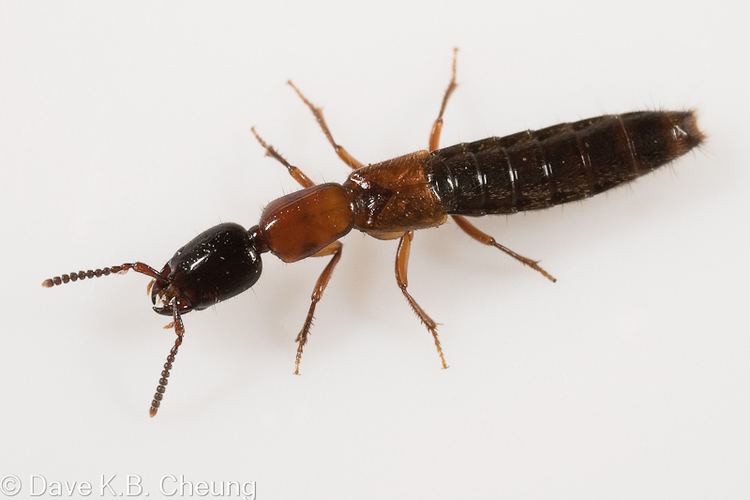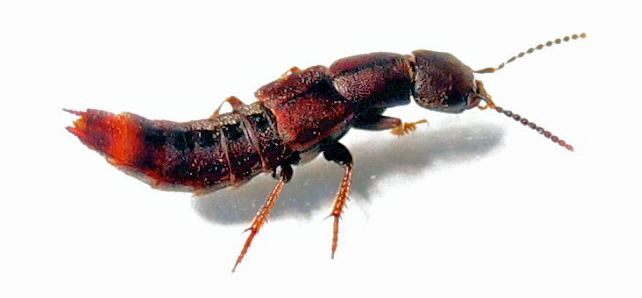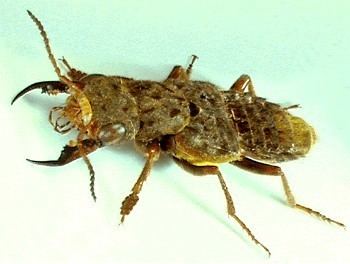Scientific name Staphylinidae Rank Family | Superfamily Staphylinoidea Order Beetle | |
 | ||
Lower classifications Paederus, Aleocharinae, Pselaphinae, Devil's coach hor, Stenus | ||
Take off and wing folding motion in a rove beetle
The rove beetles are a family (Staphylinidae) of beetles, primarily distinguished by their short elytra (wing covers) that typically leave more than half of their abdomens exposed. With roughly 63,000 species in thousands of genera, the group is currently recognized as the largest extant family of beetles. It is an ancient group, with fossilized rove beetles known from the Triassic, 200 million years ago, and possibly even earlier if the genus Leehermania proves to be a member of this family. They are an ecologically and morphologically diverse group of beetles, and commonly encountered in terrestrial ecosystems.
Contents
- Take off and wing folding motion in a rove beetle
- Attack by a strange insect tomcat rove beetles in surabaya indonesia
- Anatomy
- Ecology
- Systematics
- Important works on Staphylinidae
- Regional works
- References

One well-known species is the devil's coach horse beetle. For some other species, see list of British rove beetles.

Attack by a strange insect tomcat rove beetles in surabaya indonesia
Anatomy

As might be expected for such a large family, considerable variation exists among the species. Sizes range from <1 to 35 mm (1.4 in), with most in the 2–8 mm range, and the form is generally elongated, with some rove beetles being ovoid in shape. Colors range from yellow and red to reddish-brown to brown to black to iridescent blue and green. The antennae usually have 11 segments and are filiform, with moderate clubbing in some genera. The abdomen may be very long and flexible, and some rove beetles superficially resemble earwigs.

Some members of Paederina (specifically the genus Paederus), a subtribe of Paederinae, contain a potent vesicant in their haemolymph which can produce a skin irritation called dermatitis linearis. which in English has unfortunately acquired the inaccurate name Paederus dermatitis. The irritant pederin is highly toxic, more potent than cobra venom.
Ecology
Rove beetles are known from every type of habitat in which beetles occur, and their diets include just about everything except the living tissues of higher plants, but now including higher plants with the discovery of the diet of Himalusa thailandensis. Most rove beetles are predators of insects and other invertebrates, living in forest leaf litter and similar decaying plant matter. They are also commonly found under stones, and around freshwater margins. Almost 400 species are known to live on ocean shores that are submerged at high tide although these are much fewer than 1% of the worldwide total of Staphylinidae. These include the pictured rove beetle;. Other species have adapted to live as inquilines in ant and termite colonies, and some live in mutualistic relationships with mammals whereby they eat fleas and other parasites, benefiting the host. A few species, notably those of the genus Aleochara, are scavengers and carrion feeders, or are parasitoids of other insects, particularly of certain fly pupae.

Although rove beetles' appetites for other insects would seem to make them obvious candidates for biological control of pests, and empirically they are believed to be important controls in the wild, experiments using them have not been notably successful. Greater success is seen with those species (genus Aleochara) that are parasitoids.
Rove beetles of the genus Stenus are very interesting insects. They are specialist predators of small invertebrates such as collembola. Their labium can shoot out from the head using blood pressure. The thin rod of the labium ends in a pad of bristly hairs and hooks and between these hairs are small pores that exude an adhesive glue-like substance, which sticks to prey.
Systematics
Classification of the 63,000 (as of 2015) staphylinid species is ongoing and controversial, with some workers proposing an organization of as many as 10 separate families, but the current favored system is one of 31 subfamilies, about 100 tribes (some grouped into supertribes), and about 3,200 genera. About 400 new species are being described each year, and some estimates suggest three-quarters of tropical species are as yet undescribed.
Important works on Staphylinidae
For the Palaearctic fauna, the most up-to-date works are:
Regional works
Europe
